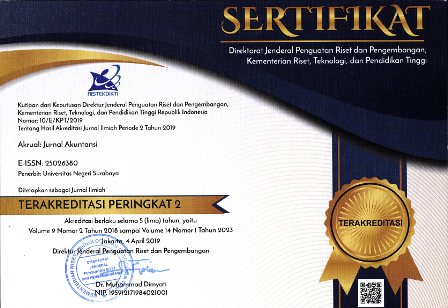Interactive Control System Analysis On Corporate Sustainability Performance : Good Corporate Governance as Mediating Variable
DOI:
https://doi.org/10.26740/jaj.v10n1.p47-56Keywords:
Corporate Sustainability Performance, Good Corporate Governance, Interactive Control System, Semen IndonesiaAbstract
The purpose of this research is to test how the measurement of interactive control system can improve corporate sustainability performance through good corporate governance. This research is a survey study with the object of research of decision makers of echelon 2 and up level in Semen Indonesia, by distributing questionnaires. In analyzing the data used structural equation modeling. Measurement model to test reliability and validity while the model structural measurement is measured by the mean R2 for the dependent variable and the path coefficient test. Out of 39 questionnaires collected, 33 questionnaires were eligible for processing. The results showed a positive relationship between Interactive Control on Corporate Governance, negative relationship between Corporate Governance to Sustainability Corporate Performance, and positive relationship between Interactive Control to Sustainability Corporate Performance. So the interactive control system can directly improve corporate sustainability performance, while good corporate governance. Can not mediate the relationship of interactive control system and corporate sustainability performance.
References
Adler, P. S., & Chen, C. X. (2011). Combining Creativity and Control: Understanding Individual Motivation in Large-Scale Collaborative Creativity. SSRN Electronic Journal. doi:10.2139/ssrn.1471341
Al-Gahtani, S. S., Hubona, G. S., & Wang, J. (2007). Information technology (IT) in Saudi Arabia: Culture and the acceptance and use of IT. Information & Management, 44(8), 681691. doi:10.1016/j.im.2007.09.002
Baines, A., & Langfield-Smith, K. (2003). Antecedents to management accounting change: a structural equation approach. Accounting, Organizations and Society, 28(7-8), 675698. doi:10.1016/s0361-3682(02)00102-2
Birkinshaw, J., Morrison, A., & Hulland, J. (1995). Structural and competitive determinants of a global integration strategy. Strategic Management Journal, 16(8), 637655.
doi:10.1002/smj.4250160805
Bisbe, J., Batista-Foguet, J.-M., & Chenhall, R. (2007). Defining management accounting constructs: A methodological note on the risks of conceptual misspecification. Accounting, Organizations and Society, 32(7-8), 789820. doi:10.1016/j.aos.2006.09.010
Bisbe, J., & Malagueño, R. (2009). The Choice of Interactive Control Systems under Different Innovation Management Modes. European Accounting Review, 18(2), 371405.
doi:10.1080/09638180902863803
Bisbe, J., & Otley, D. (2004). The effects of the interactive use of management control systems on product innovation. Accounting, Organizations and Society, 29(8), 709737.
doi:10.1016/j.aos.2003.10.010
Burchell, S., Clubb, C., Hopwood, A., Hughes, J., & Nahapiet, J. (1980). The roles of accounting in organizations and society. Accounting, Organizations and Society, 5(1), 527. doi:10.1016/0361-3682(80)90017-3
Burton-Jones, A., & Hubona, G. S. (2006). The mediation of external variables in the technology acceptance model. Information & Management, 43(6), 706717. doi:10.1016/j.im.2006.03.007
CambraFierro, J., & RuizBenÃtez, R. (2011). Sustainable business practices in Spain: a twocase study. European Business Review, 23(4), 401412. doi:10.1108/09555341111145780
Camisón, C., & Villar López, A. (2010). An examination of the relationship between manufacturing flexibility and firm performance. International Journal of Operations & Production Management, 30(8), 853878. doi:10.1108/01443571011068199
Chenhall, R. H., Kallunki, J.-P., & Silvola, H. (2011). Exploring the Relationships between Strategy, Innovation, and Management Control Systems: The Roles of Social Networking, Organic Innovative Culture, and Formal Controls. Journal of Management Accounting Research, 23(1), 99128. doi:10.2308/jmar-10069
Crowther, D. (2008). Corporate Social Responsibility: Bookboon.
Crutzen, B. S. Y., Swank, O. H., & Visser, B. (2013). Confidence Management: On Interpersonal Comparisons in Teams. Journal of Economics & Management Strategy, 22(4), 744767. doi:10.1111/jems.12037
Djamilah, S., & Surenggono, S. (2017). Corporate Social Responsibility Sebagai Variabel Pemediasi Pengaruh Good Corporate Governance Terhadap Kinerja Keuangan. AKRUAL: Jurnal Akuntansi, 9(1), 41. doi:10.26740/jaj.v9n1.p41-53
Dillman, D. A. (1972). Increasing Mail Questionnaire Response in Large Samples of the General Public. Public Opinion Quarterly, 36(2), 254. doi:10.1086/267997
Hartmann, F., & SlapniÄar, S. (2009). How formal performance evaluation affects trust between superior and subordinate managers. Accounting, Organizations and Society, 34(6-7), 722737. doi:10.1016/j.aos.2008.11.004
Henri, J.-F. (2006). Management control systems and strategy: A resource-based perspective. Accounting, Organizations and Society, 31(6), 529558. doi:10.1016/j.aos.2005.07.001
Henseler, J., Ringle, C. M., & Sinkovics, R. R. (Eds.). (2009). The Use of Partial Least Squares Path Modeling in International Marketing. Advances in Intenational Marketing, 20: 277-319.
Hulland, J. (1999). Use of Partial Least Squares (PLS) in Strategic Management Research: A Review of Four Recent. Strategic Management Journal, 20(2): 195. https://doi.org/10.1002
Jobber, D. (1989). An examination of the effects of questionnaire factors on response to an industrial mail survey. International Journal of Research in Marketing, 6(2), 129140.
doi:10.1016/0167-8116(89)90006-2
Kaplan, R. S., & Norton, D. P. (1996). The Balanced Scorecard: Translating Strategy into Action Boston, MA: Harvard Business School Press.
Kaplan, R. S., & Norton, D. P. (2006). Alignment Using the Balanced Scorecard to Create Corporate Strategies. Boston, Massachusetts: Harvard Business School Press.
Kementrian Badan Usaha Milik Negara Republik Indonesia. (2017). Penerapan Praktek Good Corporate Governance pada Badan Usaha Milik Negara(KEP100/MBU/2002) http://jdih.bumn.go.id/
Mersereau, A., & Mottis, N. (2011). Corporate Social Responsibility and Management Control. SSRN Electronic Journal. doi:10.2139/ssrn.2331990
Naranjo-Gil, D., & Hartmann, F. (2007a). How CEOs use management information systems for strategy implementation in hospitals. Health Policy, 81(1), 2941. doi:10.1016/j.healthpol.2006.05.009
Naranjo-Gil, D., & Hartmann, F. (2007b). Management accounting systems, top management team heterogeneity and strategic change. Accounting, Organizations and Society, 32(7-8), 735756. doi:10.1016/j.aos.2006.08.003
Peni, E., & Vähämaa, S. (2011). Did Good Corporate Governance Improve Bank Performance during the Financial Crisis? Journal of Financial Services Research, 41(1-2), 1935. doi:10.1007/s10693-011-0108-9
Simons, G. (1995). Beginnings. Korea, 6388. doi:10.1007/978-1-349-23950-4_2
Simons, R. (1990). The role of management control systems in creating competitive advantage: New perspectives. Accounting, Organizations and Society, 15(1-2), 127143. doi:10.1016/0361-3682(90)90018-p
Simons, R. (1991). Strategic orientation and top management attention to control systems. Strategic Management Journal, 12(1), 4962. doi:10.1002/smj.4250120105
Shelleman, J. M., & Shelleman, J. M. (1995). Levers of Control: How Managers Use Innovative Control Systems to Drive Strategic Renewal by Simons Robert, Boston, MA; Harvard Business School Press, 1995215 pages, hard cover, $29.95. Academy of Management Perspectives, 9(2), 8284.
doi:10.5465/ame.1995.9506273288
Otley, D. T., & Berry, A. J. (1994). Case study research in management accounting and control. Management Accounting Research, 5(1), 4565. doi:10.1006/mare.1994.1004
Simons, R. (2000). Performance Measurement and Control Systems for Implementing Strategy. New Jersey: Prentice-Hall.
Smith, D., & Langfield-Smith, K. (2004). Structural Equation Modeling in Management Accounting Research: Critical Analysis and Opportunity. Journal of Accounting Literature, 23: 49-89.
Svensson, G., & Wagner, B. (2011). Transformative business sustainability. European Business Review, 23(4), 334352. doi:10.1108/09555341111145735
CambraFierro, J., & RuizBenÃtez, R. (2011). Sustainable business practices in Spain: a twocase study. European Business Review, 23(4), 401412.
doi:10.1108/09555341111145780
Morsing, M., & Oswald, D. (2009). Sustainable leadership: management control systems and organizational culture in Novo Nordisk A/S. Corporate Governance: The International Journal of Business in Society, 9(1), 8399. doi:10.1108/14720700910936083
Downloads
Published
How to Cite
Issue
Section
 Abstract views: 952
,
Abstract views: 952
, PDF Downloads: 735
PDF Downloads: 735


















